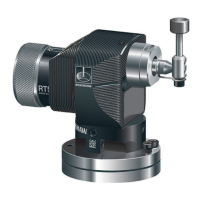3.13
System
installation
Calibrating the RTS
Why calibrate a probe?
A probe is just one component of the measurement system which communicates with the machine
tool. Each part of the system can introduce a constant difference between the position that the stylus
touches and the position that is reported to the machine. If the probe is not calibrated, this difference
will appear as an inaccuracy in the measurement. Calibration of the probe allows the probing software
to compensate for this difference.
During normal use, the difference between the touch position and the reported position does not
change, but it is important that the probe is calibrated in the following circumstances:
• When a probe system is to be used for the first time.
• When the trigger filter is changed.
• When a new stylus is fitted to the probe.
• When it is suspected that the stylus has become distorted or that the probe has been crashed.
• At regular intervals to compensate for mechanical changes of your machine tool.
When your probe is assembled and mounted on the machine table, it is necessary to align the stylus
faces with the machine axes to avoid probing errors when setting tools. It is worth taking care with this
operation – you should try to get the faces aligned to within 0.010 mm (0.0004in) for normal use. This
is achieved by manually adjusting the stylus with the adjusting screws provided, and using a suitable
instrument such as a DTI clock mounted in the machine spindle.
When the probe has been correctly set up on the machine, it is time to calibrate the probe. Calibration
cycles are available from Renishaw for this task. The purpose is to establish the probe stylus
measuring face trigger point values under normal measuring conditions.
Calibration should be run at the same speed as probing.
The calibration values are stored in macro variables for computation of the tool size during tool setting
cycles.
Values obtained are axis trigger positions (in machine coordinates). Any errors due to machine and
probe triggering characteristics are automatically calibrated out in this way. These values are the
electronic trigger positions under dynamic operating conditions, and not necessarily the true physical
stylus face positions.
NOTE: Poor repeatability of probe trigger point values indicates that either the probe/stylus assembly
is loose or a machine/probe fault exists. Further investigation is required.

